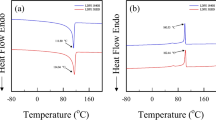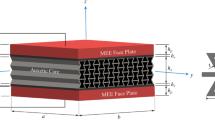Abstract
During the stretch blow moulding (SBM) process of polyethylene terephthalate (PET) bottle, high viscous dissipation generates self heating phenomena. Since the influence of temperature on polymer’s behavior is important, it is necessary to evaluate the self heating values in order to manage accurately the simulation of the process. An anisotropic visco-hyperelastic model has been developed to manage numerical simulations of free blowing. The model takes into account the anisotropy and the effect of the temperature. It has been computed in a user-interface VUMAT implemented in the software ABAQUS/Explicit. The identification of the model is based on experimental data of biaxial tension tests. We identified the characteristics taking into account the self-heating effect by a semi analytical process followed by an adjustment using finite element. For sake of validation, PET preforms have been blown from different initial temperature and followed using a thermal camera. The increase of temperature is measured by comparing initial temperature and final temperature. Comparison between the experimental and numerical simulations is discussed and influence of initial temperature or blowing pressure is highlighted in a large numerical investigation.









Similar content being viewed by others
References
Yousefi A, DiRaddo R, Bendada A Simulation of the mobile preform reheat in injection stretch blow moulding process. Polymer Proceeding Society 17. Montreal, Canada. May 21–24 2001
Haung HX, Yin ZS, Liu JH (2007) Visualisation study and analysis on preform growth in polyethylene terephthalate stretch blow moulding. J Appl Polym Sci 103(1):564–573
Billon N, Erner A, Gorlier E (2005) Kinematics of stretch blow moulding and plug assisted thermoforming of polymers; experimental study, Polymer Proceeding Society 21. Leipzig, Germany
Nagarjappa CC (2012) PhD. Thesis, Developing and validating stretch blow moulding simulation through free blow experiments, Queens University Belfast, School of Mechanical & Aerospace Engineering
Menary GH, Tan CW, Harkin-Jones EMA, Armstrong CG, Martin PJ (2012) Biaxial deformation of PET at conditions applicable to the stretch blow molding process. Polym Eng Sci 52(3):671–688
Chevalier L, Luo YM, Monteiro E, Menary G (2012) Onvisco-elastic modelling of polyethylene terephthalate behaviour during multiaxial elongations slightly over the glass transition temperature. Mech Mater 52:103–116
Luo YM, Chevalier L (2019) On induced properties and self heating during free blowing of PET preform. Int Polym Process 34(3):330–338
Marco Y (2003) Caractérisation Multi-Axiale du Comportement et de la Micro-Structure d’un Semi-Cristallin: Application au Cas du P.E.T., PhD Thesis, ENS Cachan, Cachan
Bedoui F (2005) Etude du Comportement Elastique et Viscoélastique Linéaire des Polymères Semi-Cristallins par Approche Micromécanique, PhD Thesis, ENSAM, Paris
Gong YH (2018) Sur l’Analyse Multiéchelle du Changement de Morphologie du PET sous l’effet de la Température ou des Sollicitations Mécaniques, PhD Thesis, University Paris-Est, Marne-la-Vallée
Lebaudy P, Saiter JM, Grenet J, Vautier C (1995) Temperature distribution in poly(ethylene terephthalate) plate undergoing heat treatment. Diffusion Influence and Application, Polymer 36(6):1217–1221
Schmidt FM, Le Maoult Y, Monteix S (2003) Modelling of infrared heating of thermoplastic sheet used in thermoforming process. J Mater Process Technol 143–144:225–231
Monteix S, Schmidt F, Le Maoult Y (2001) Experimental study and numerical simulation of preform or sheet exposed to infrared radiative heating. J Mater Process Technol 119(1–3):90–97
Huang HX, Li YZ, Deng YH (2006) Online real-time acquisition for transient temperature in blow molding. Polym Test 25(6):839–845
Salomeia YM, Menary GH, Armstrong CG (2013) Experimental investigation of stretch blow molding, part 1: instrumentation in an industrial environment. Advances in Polymer Technology 32(S1):E771–E783
Menary G (2012) The effect of temperature, strain rate and strain on the induced mechanical properties of Biaxially stretched PET. The 17th annual ESAFORM conference on material forming, Erlangen, German, 14–16 March 2012
Huang H-X, Deng Y-H, Huang Y-F (2005) Temperature profiles within reheated preform in stretch blow molding. ANTEC’05, Boston, Massachusetts
Champin C (2007) Modélisation 3D du chauffage par rayonnement infrarouge et de l’étirage soufflage de corps creux en P.E.T., PhD thesis, Ecole Nationale Supérieure des Mines de Paris
Michaeli W, Papst W (2004) FE-Analysis of the Two-Step Stretch Blow Molding Process. in SPE ANTEC Technical Papers 30 , Chicago, USA
Martin L, Stracovsky D, Laroche D, Bardetti A, Ben-Yedder R, DiRaddo R (1999) Modeling and experimental validation of the stretch blow molding of PET. In SPE ANTEC Technical Papers, New York
Cosson B, Schmidt F, Le Maoult Y, Bordival M (2011) Infrared heating stage simulation of semi-transparent media (PET) using ray tracing method. Int J Mater Form 4(1):1–10
Luo YM, Chevalier L, Utheza F, Monteiro E (2013) Numerical simulation of the thermodependant visco-hyperelastic behaviour of PET near the Glass Transition Temperature: prediction of the self heating during biaxail tension test, Polymer Eng. & Science, on line
Luo YM, Chevalier L, Utheza F, Nicolas X (2014) Simplified modelling of the infrared heating involving the air convection effect before the injection stretch blowing moulding of PET preform, ESAFORM, Espoo, Finland, May 2014
Luo YM, Chevalier L, Monteiro E, Utheza F (2017) Self heating during stretch blow molding: an experimental numerical comparison, the 20th international ESAFORM conference on material forming, Dublin, Ireland, April 26-28, 2017
Schmidt FM, Agassant JF, Bellet M (1998) Experimental study and numerical simulation of the injection stretch/blow moulding process. Poly Eng Sci 38(9):1399–1412
Menary GH, Tan CW, Picard M, Billon N Armstrong CG, Harkin- Jones EMA (2007) Numerical simulation of injection stretch blow moulding: comparison with experimental free blow trials. 10th ESAFORM conference on material forming, AIPConf Proc, vol 907, pp 939–944
Salomeia YM (2009) PhD Thesis, Improved understanding of injection stretch blow moulding through instrumentation, process monitoring and modelling. Queen’s University of Belfast, School of mechanical & Aerospace Engineering
Bordival M, Schmidt FM, Le Maoult Y, Velay V (2009) Optimization of preform temperature distribution for stretch-blow moulding of PET bottles: infrared heating and blowing modelling. Polym Eng Sci 49(4):783–793
Nixon J, Menary GH, Yan S (2017) Finite element simulations of stretch-blow moulding with experimental validation over a broad process window. Int J Mater Form 10(5):793–809
Barakos G, Mitsoulis E (1996) Non-isothermal viscoelastic simulations of extrusion through dies and prediction of the bending phenomenon. J Nonnewton Fluid Mech 62(1):55–79
Marckman G, Verron E, Peseux B (2001) Finite element analysis of blow molding and thermoforming using a dynamic explicit procedure. Polym Eng Sci 41(3):426–439
Buckley CP, Jones DP (1996) Hot-drawing of poly(ethylene terephthalate) under biaxial stress: application of a three-dimensional glass-rubber constitutive model. Polymer 37(12):2403–2414
Luo Y-M, Chevalier L, Monteiro E, Yan S, Menary G (2020) Simulation of the injection stretch blow moulding process: an anisotropic visco-hyperelastic model for PET behavior. Polym Eng Sci 60(4):823–831
Author information
Authors and Affiliations
Corresponding author
Ethics declarations
Conflict of interest
The authors declare that they have no conflict of interest.
Additional information
Publisher’s note
Springer Nature remains neutral with regard to jurisdictional claims in published maps and institutional affiliations.
Rights and permissions
About this article
Cite this article
Luo, YM., Chevalier, L., Monteiro, E. et al. Numerical simulation of self heating during stretch blow moulding of PET: viscohyperelastic modelling versus experimental results. Int J Mater Form 14, 703–714 (2021). https://doi.org/10.1007/s12289-020-01565-w
Received:
Accepted:
Published:
Issue Date:
DOI: https://doi.org/10.1007/s12289-020-01565-w




